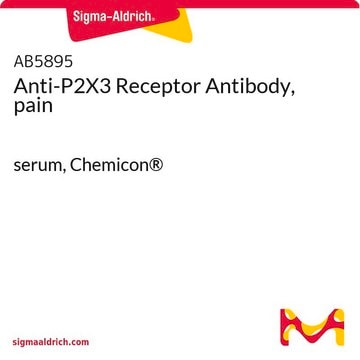AB5896
Anti-P2X3 Receptor Antibody, pain
serum, Chemicon®
Synonyme(s) :
P2X3 Antibody
About This Item
Produits recommandés
Source biologique
guinea pig
Niveau de qualité
Forme d'anticorps
serum
Type de produit anticorps
primary antibodies
Clone
polyclonal
Espèces réactives
human, rat, mouse
Fabricant/nom de marque
Chemicon®
Technique(s)
immunocytochemistry: suitable
immunohistochemistry: suitable
Numéro d'accès NCBI
Numéro d'accès UniProt
Conditions d'expédition
dry ice
Modification post-traductionnelle de la cible
unmodified
Informations sur le gène
human ... P2RX3(5024)
Spécificité
Immunogène
Control Peptide: Catalog Number AG356
Application
Immunocytochemistry: 1:1,000.
Optimal working dilutions must be determined by end user.
APPLICATION NOTES FOR AB5896
IMMUNOHISTOCHEMISTRY
Male Sprague-Dawley rats (b.wt. 100-150g) were anesthetized with sodium pentobarbital and perfused via the ascending aorta with: 1) 50 mL of Ca2+-free Tyrode+s solution followed by 2) a formalin-picric acid fixative (4% paraformaldehyde with 0.4% picric acid in 0.16 M phosphate buffer, pH 6.9) and 3) 10% sucrose in PBS as a cryo-protectant. Tissues were rapidly dissected out and stored overnight in 0.1 M phosphate buffer (pH 7.4) containing 10% sucrose. Slide-mounted tissue sections were incubated with blocking buffer for 1 hour at room temperature. Primary antibody was diluted in blocking buffer to the appropriate working dilution. Blocking buffer was removed and the slides were then incubated at 2-8°C for 18-24 hours with AB5896 (1:1,000). After rinsing in PBS 3 times sections were incubated for 60 minutes at room temperature with Cy3-conjugated secondary antibodies. After mounting in a mixture of PBS and glycerol (1:3) containing 0.1% p-phenylenediamine, sections were examined with a Nikon Microphot-SA epifluorescence microscope.
IMMUNOCYTOCHEMISTRYP
2X3 transfected cells were processed for indirect immunofluorescence. Media was removed and cells were gently washed 3 times with serum-free media. Following fixation procedure, cells were processed for indirect immunofluorescence as above.
Neuroscience
Neurotransmitters & Receptors
Neuroinflammation & Pain
Forme physique
Stockage et stabilité
Informations légales
Clause de non-responsabilité
Not finding the right product?
Try our Outil de sélection de produits.
Code de la classe de stockage
10 - Combustible liquids
Classe de danger pour l'eau (WGK)
WGK 1
Certificats d'analyse (COA)
Recherchez un Certificats d'analyse (COA) en saisissant le numéro de lot du produit. Les numéros de lot figurent sur l'étiquette du produit après les mots "Lot" ou "Batch".
Déjà en possession de ce produit ?
Retrouvez la documentation relative aux produits que vous avez récemment achetés dans la Bibliothèque de documents.
Notre équipe de scientifiques dispose d'une expérience dans tous les secteurs de la recherche, notamment en sciences de la vie, science des matériaux, synthèse chimique, chromatographie, analyse et dans de nombreux autres domaines..
Contacter notre Service technique








